Britain is increasingly vulnerable to the threat of missiles and drones after decades of cost-saving cuts have eroded its once world-class air defenses, military sources and Cold War veterans have warned.
Defense chiefs are believed to be exploring options to restore Britain’s ability to protect critical national infrastructure – such as power stations, military bases and government buildings – from the type of Russian cruise attacks and ballistic missiles that are devastating Ukraine.
But any credible “integrated air and missile defense” plan will cost billions of pounds and will likely require a further increase in defense spending. in addition to a proposed increase to 2.5% of national income recently announced by the Prime Ministeraccording to defense sources.
“Will the UK be able to defend its cities from the skies if there is a missile barrage? No,” said a senior defense source, speaking on condition of anonymity.
“Does the public know what to do in the event of an air raid? No… Simply put, are we defended? No.”
As part of a series called Prepared For War? Sky News visited air defense sites that once played a key role in protecting Britain during the Cold War – and spoke to veterans who were part of the force that was on alert to respond to any Soviet air threat.
Pressing the big red button
Flicking a row of switches to prime a simulated batch of missiles from inside a cockpit at a former military base-turned-museum in Norfolk, a former Royal Air Force technician watches a screen while a radar searches for enemy aircraft.
“It detected a target,” says Robert Findlater, pointing to a dot on the monitor that looks like a retro computer game.
Robert Findlater, a former Royal Air Force technician who was with the UK’s Bloodhound unit
An audible signal indicates that the radar signal is becoming stronger as the hostile aircraft approaches.
Once within range, red letters on one of the screens that read “maintain fire” change to the words: “free to fire”, written in green.
Mr. Findlater, leans forward and presses a big red button.
Suddenly, there is a bang as the simulated noise of a missile taking off shakes the cabin.
The Bloodhound air defense missile, powered by a Rolls Royce engine, could reach 60 miles per hour in a tenth of a second before firing at twice the speed of sound as it hurtled towards an enemy aircraft or missile – cutting-edge technology in your day.
“We were successful in our launch,” says the RAF veteran, with a smile.

Bloodhound air defense missile could reach 60 miles per hour in a tenth of a second
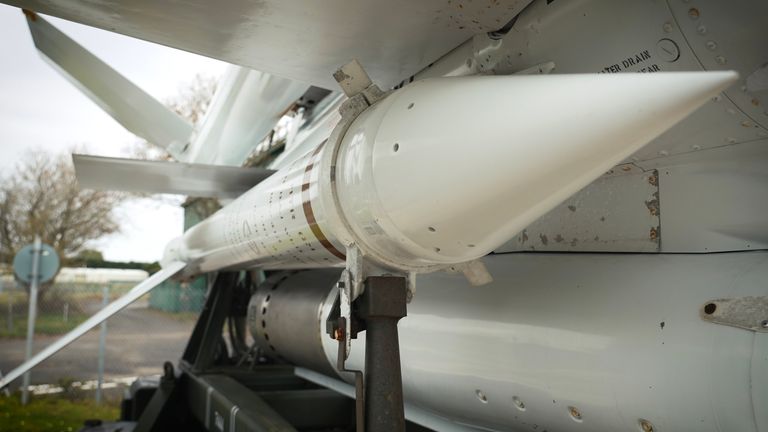
It could then fire at up to twice the speed of sound while charging toward an enemy aircraft or missile.
He then looks back at the screen, watching a line of what appear to be radio waves bounce up and down, until there is a spike to indicate the missile is approaching the target.
“This [the radar] Now she’s looking for the missile, and there she is in the beam. The next thing you see is the warhead.
“It fired and you killed him”, says the veteran, ending the simulation.
Long retired, Mr Findlater joined the RAF in 1968.
He rose through the ranks to become chief technician of a Bloodhound unit, tasked with ensuring the missiles were ready and capable of firing at any threat at all times.
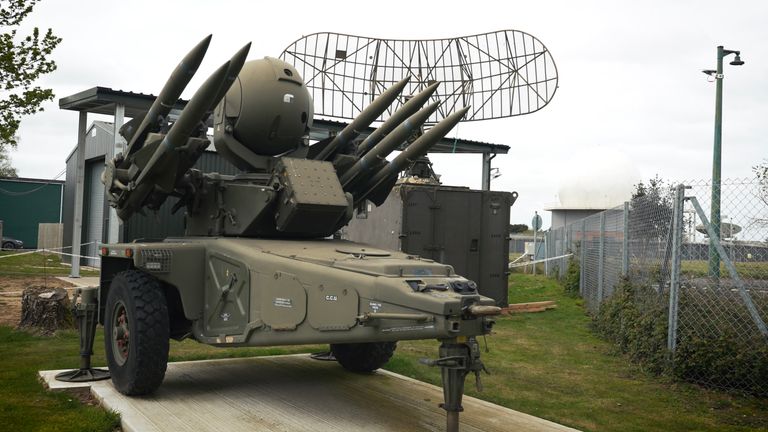
Retired equipment at the RAF Air Defense Radar Museum in Norfolk
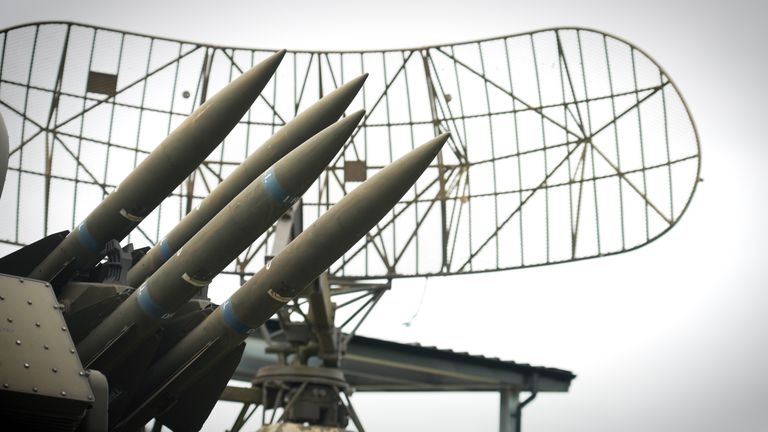
Stepping out of the cockpit, where the system was operated, onto a patch of grass, the veteran showed Sky News the real weapon – a lethal-looking collection of rockets and warheads, painted white and now horizontal, rather than pointing straight ahead. the sky.
Asked what message it was designed to send to NATO’s former enemies in the Warsaw Pact, Findlater said with a laugh: “Don’t come knocking… It says we’re ready for you.”
The ground-based systems, spread across the UK coast, used to be part of a layered network of Cold War air defenses that also included fighter jets and other weapons.
But the entire arsenal of Bloodhound air defense missiles was taken out of service after the collapse of the Soviet Union in 1991, while air bases and fast jet squadrons were scaled back to save money as successive prime ministers received what was described as a “peace dividend”.

At the time, there was talk of investing in US-made Patriot air defense systems – an even more capable kit that remains an essential part of the air defenses of the United States and several other NATO allies.
“But I think the government just gave up and shut everything down because there was no longer a threat,” Findlater said.
Asked if he thought the UK was well defended now, he said: “I don’t feel we are defended, no, not at all.”
As for how that made him feel, he said, “Sad… Considering what we had in the 1970s and 1980s.”
Frozen in time
Also in the RAF Air Defense Radar Museum is an old Cold War operations room – frozen in time, with giant plaques along one wall, recording the number of fighters that were ready to attack.
There are also rows of tables, equipped with radar screens and important-looking buttons.
John Baker, 69, previously worked at this center as an aircraft identification and recognition officer.
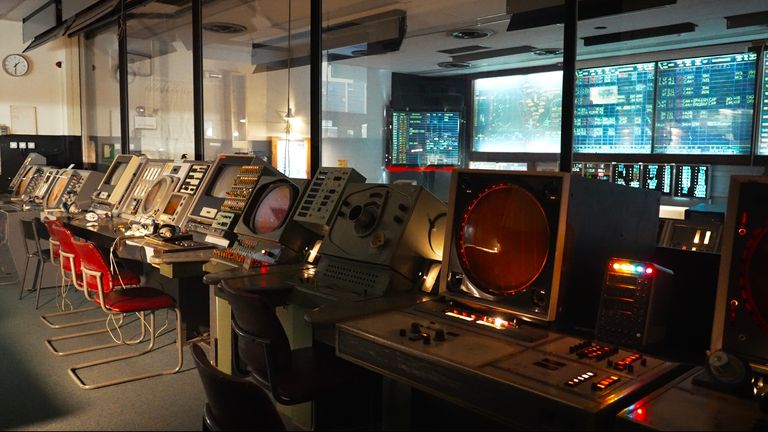
A former Cold War operations room at the RAF Air Defense Radar Museum

John Baker, 69, previously worked as an aircraft identification and reconnaissance officer
Asked whether the UK’s air defenses were prepared for war when he served, he said: “We practiced. There were exercises for war.
“Every two months or so there would be a small exercise and once or twice a year there would be a big NATO exercise where this – because this radar site was closest to Europe – would be the epicenter.”
While he cautioned that he was no longer up to date on the military’s air defense capabilities, he seemed less certain about whether they could handle a major attack today.
This content is provided by Speaker, which may use cookies and other technologies. To show you this content, we need your permission to use cookies. You can use the buttons below to change your preferences to activate Speaker cookies or allow these cookies only once. You can change your settings at any time via the Privacy Options.
Unfortunately we are unable to verify whether you have consented Speaker cookies. To view this content you can use the button below to allow Speaker cookies for this session only.
Click to subscribe to Sky News Daily wherever you get your podcasts
“If hundreds and hundreds of drones and cruise missiles came. I don’t think we could eliminate them all safely,” Baker said.
He added: “I’m glad I served my sentence then – and not now.”
‘Woefully inadequate’ air defenses
The UK has highly capable air defense equipment – but it is no longer sufficient to protect the vast array of critical infrastructure across the country and also to defend troops deployed on overseas operations.

Keep up with the latest news from the UK and around the world by following Sky News
Making the situation more serious is the increase in the quality and quantity of missiles and drones that hostile countries such as Russia, China, Iran and North Korea have developed.
Currently, the RAF has just nine squadrons of fast jets on the front line – including quick reaction alert aircraft that are at the forefront of defense against any aerial threat.
Although modern jets – the F-35 and Typhoon – are far more sophisticated than their predecessors, the UK had 30 squadrons on the front line at the end of the Cold War.
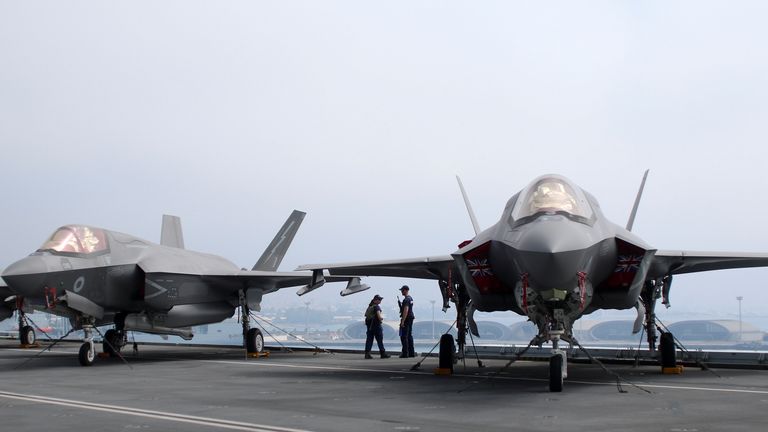
RAF F-35B Lightning II aircraft, seen on the deck of HMS Queen Elizabeth docked in Limassol, Cyprus, in 2021. Photo: Reuters
O of the Royal Navy six Type 45 destroyers are equipped with the country’s only ballistic missile defense systems.
But only three of these ships are “available for operations,” according to a Navy spokesperson, including one that is deployed on operations in the Middle East.
On land, the military has about six Sky Saber ground-based air defense systems – each capable of shooting down multiple missiles.
But at least two of these weapons – almost certainly more – are deployed overseas, and the UK’s only have a very limited range.
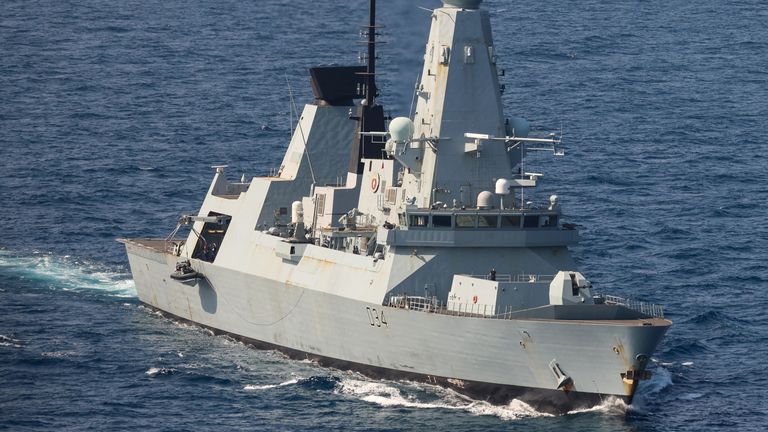
HMS Diamond is one of six Type 45 destroyers in the Royal Navy. Photo: Reuters
Read more on Sky News:
Is the UK preparing for war amid threats of conflict?
Analysis: It’s hard to imagine how the UK could be doing less to prepare for war
Jack Watling, a senior research fellow at the Royal United Services Institute, called the UK’s current suite of air defenses “woefully inadequate”.
Britain benefits from its geography, with many European NATO countries between its shores and Russia.
However, the air defenses of many European nations have also been reduced to save money since the collapse of the Soviet Union.
“We always hear the argument from the Ministry of Defense that gaps in our own capability are acceptable because we are part of an alliance,” Watling said.
“It’s a bit like if you’re going to a BYOB party and you say, ‘Well, there’s other people coming, so I’m not bringing alcohol.’
“If everyone adopts this approach, then there will simply be nothing to drink. And when we look at all of NATO, there is a general shortage [in air defences].”
A Ministry of Defense spokesperson said: “The UK is well prepared for any event and the defense of the UK would be undertaken alongside our NATO allies.
“As part of our commitment to invest an additional £75 billion in defense over the next six years, we continue to review potential opportunities to develop our capabilities and modernize air defense across Europe, in close discussion with allies and partners. .”
This story originally appeared on News.sky.com read the full story












/cdn.vox-cdn.com/uploads/chorus_asset/file/25572498/2166616293.jpg?w=300&resize=300,300&ssl=1)























